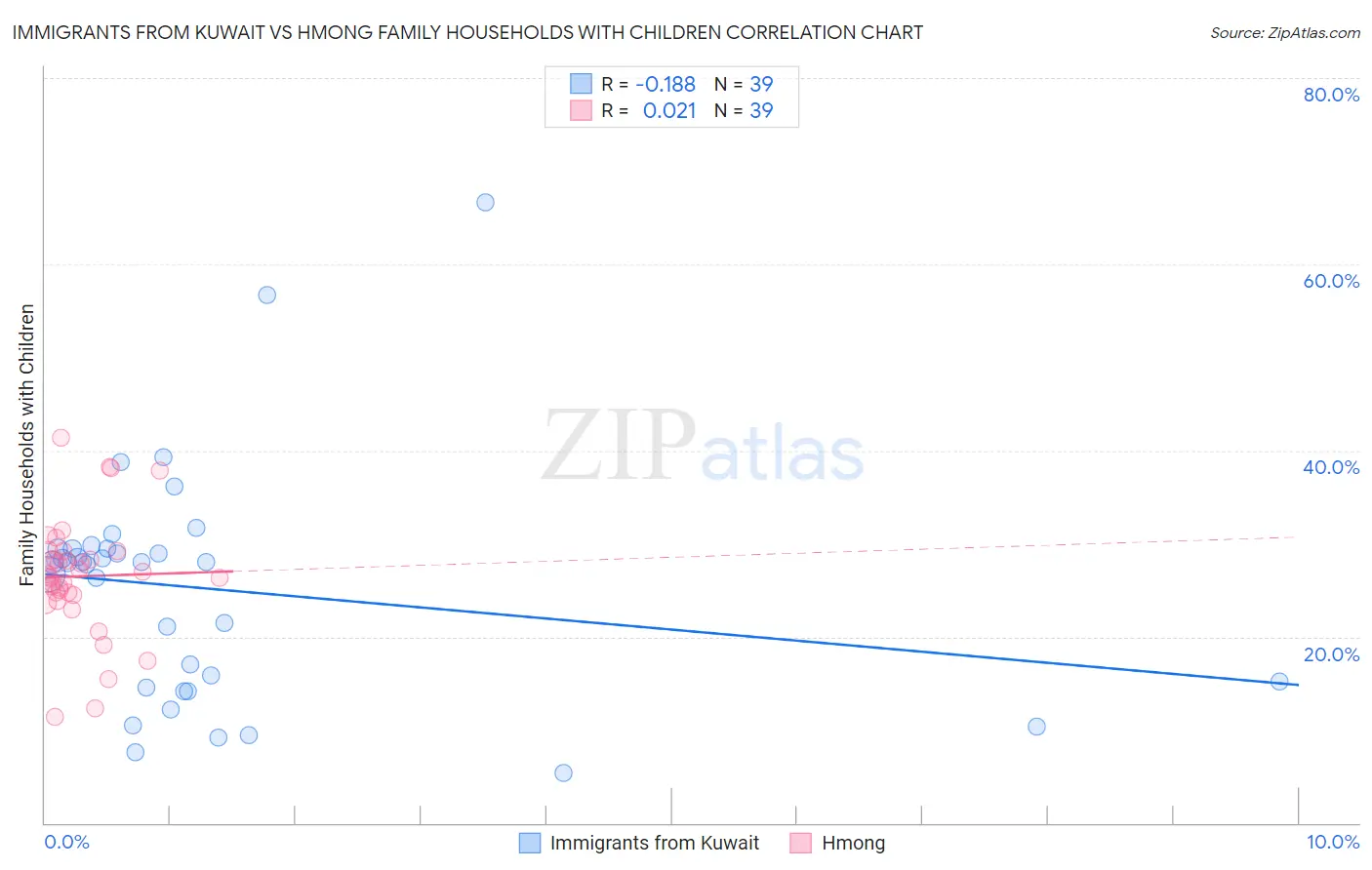Immigrants from Kuwait vs Hmong Family Households with Children
COMPARE
Immigrants from Kuwait
Hmong
Family Households with Children
Family Households with Children Comparison
Immigrants from Kuwait
Hmong
27.5%
FAMILY HOUSEHOLDS WITH CHILDREN
60.9/ 100
METRIC RATING
168th/ 347
METRIC RANK
28.6%
FAMILY HOUSEHOLDS WITH CHILDREN
99.9/ 100
METRIC RATING
60th/ 347
METRIC RANK
Immigrants from Kuwait vs Hmong Family Households with Children Correlation Chart
The statistical analysis conducted on geographies consisting of 136,880,094 people shows a poor negative correlation between the proportion of Immigrants from Kuwait and percentage of family households with children in the United States with a correlation coefficient (R) of -0.188 and weighted average of 27.5%. Similarly, the statistical analysis conducted on geographies consisting of 24,678,157 people shows no correlation between the proportion of Hmong and percentage of family households with children in the United States with a correlation coefficient (R) of 0.021 and weighted average of 28.6%, a difference of 3.9%.

Family Households with Children Correlation Summary
| Measurement | Immigrants from Kuwait | Hmong |
| Minimum | 5.3% | 11.4% |
| Maximum | 66.6% | 41.4% |
| Range | 61.3% | 30.0% |
| Mean | 25.1% | 26.5% |
| Median | 28.0% | 26.4% |
| Interquartile 25% (IQ1) | 14.5% | 24.5% |
| Interquartile 75% (IQ3) | 29.4% | 29.2% |
| Interquartile Range (IQR) | 14.9% | 4.7% |
| Standard Deviation (Sample) | 12.5% | 6.3% |
| Standard Deviation (Population) | 12.3% | 6.2% |
Similar Demographics by Family Households with Children
Demographics Similar to Immigrants from Kuwait by Family Households with Children
In terms of family households with children, the demographic groups most similar to Immigrants from Kuwait are Immigrants from South Africa (27.5%, a difference of 0.010%), Nonimmigrants (27.5%, a difference of 0.010%), Dominican (27.5%, a difference of 0.010%), Immigrants from Hong Kong (27.5%, a difference of 0.090%), and Seminole (27.5%, a difference of 0.090%).
| Demographics | Rating | Rank | Family Households with Children |
| Alaskan Athabascans | 67.1 /100 | #161 | Good 27.6% |
| Immigrants | Bangladesh | 67.0 /100 | #162 | Good 27.6% |
| Czechs | 65.3 /100 | #163 | Good 27.5% |
| Immigrants | Hong Kong | 64.9 /100 | #164 | Good 27.5% |
| Immigrants | South Africa | 61.3 /100 | #165 | Good 27.5% |
| Immigrants | Nonimmigrants | 61.2 /100 | #166 | Good 27.5% |
| Dominicans | 61.1 /100 | #167 | Good 27.5% |
| Immigrants | Kuwait | 60.9 /100 | #168 | Good 27.5% |
| Seminole | 56.9 /100 | #169 | Average 27.5% |
| Cherokee | 56.7 /100 | #170 | Average 27.5% |
| Blackfeet | 54.3 /100 | #171 | Average 27.5% |
| Israelis | 53.9 /100 | #172 | Average 27.5% |
| Immigrants | Argentina | 52.2 /100 | #173 | Average 27.5% |
| Whites/Caucasians | 50.0 /100 | #174 | Average 27.4% |
| British | 49.9 /100 | #175 | Average 27.4% |
Demographics Similar to Hmong by Family Households with Children
In terms of family households with children, the demographic groups most similar to Hmong are Immigrants from Nigeria (28.6%, a difference of 0.060%), Immigrants from Ghana (28.6%, a difference of 0.070%), Egyptian (28.6%, a difference of 0.080%), Immigrants from Lebanon (28.6%, a difference of 0.090%), and Filipino (28.6%, a difference of 0.16%).
| Demographics | Rating | Rank | Family Households with Children |
| Immigrants | Cambodia | 100.0 /100 | #53 | Exceptional 28.9% |
| Sierra Leoneans | 100.0 /100 | #54 | Exceptional 28.9% |
| Immigrants | Asia | 100.0 /100 | #55 | Exceptional 28.8% |
| Immigrants | Guatemala | 100.0 /100 | #56 | Exceptional 28.8% |
| Danes | 100.0 /100 | #57 | Exceptional 28.7% |
| Hawaiians | 100.0 /100 | #58 | Exceptional 28.7% |
| Immigrants | Nigeria | 100.0 /100 | #59 | Exceptional 28.6% |
| Hmong | 99.9 /100 | #60 | Exceptional 28.6% |
| Immigrants | Ghana | 99.9 /100 | #61 | Exceptional 28.6% |
| Egyptians | 99.9 /100 | #62 | Exceptional 28.6% |
| Immigrants | Lebanon | 99.9 /100 | #63 | Exceptional 28.6% |
| Filipinos | 99.9 /100 | #64 | Exceptional 28.6% |
| Hondurans | 99.9 /100 | #65 | Exceptional 28.5% |
| Immigrants | Egypt | 99.9 /100 | #66 | Exceptional 28.5% |
| Ghanaians | 99.9 /100 | #67 | Exceptional 28.5% |